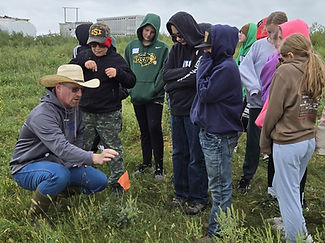

Welcome!
Foster County Soil Conservation District is here to promote soil, water, and resource conservation by offering technical, financial, informational, and educational assistance and opportunities to the people of Foster County.
Check out our programs and services. Get in touch with us if you have any questions, comments, or concerns, or if you are interested in participating in any of our programs.
2025 Eco Ed Day
On September 3rd, 56 sixth graders from Carrington and Midkota Grade Schools spent the day at Juanita Lake Park. Small groups made the rounds of six stations learning about Agronomy, Wetlands and Wildlife, Woodlands, Watersheds and Water Quality, Soils and Erosion, and Rangelands. Then all came together for a presentation by The Bugman's Daughter on insects and other invertebrates. The event gives the students an outdoor experience with opportunities for hands-on learning, real life examples, and active demonstrations. Our thanks to the teachers and chaperones, T-shirt sponsors, and all the presenters who made the day possible.






Not the Dirty Thirties, Spring of 2017!!

Photo: Storm Tracker Weather

Photo: Bev Nessler
These photos were taken spring of 2017, showing that soil erosion is still a threat to our farmland. These sights have been repeated more than once since then. See the "News and Information" page for photos from the dust storm of March 29-30, 2021. Parts of eastern North Dakota have lost over half of their topsoil since 1964.
"Most of what we call topsoil today is a mixture of the remains of the original higher organic matter topsoil mixed through tillage with some subsurface horizon. Loss of soil in millions of acres can be measured in feet over the past 120 years. Most lost soil...is going high into the air, and only a small amount lands in a roadside ditch." (Dave Franzen, NDSU) For more information, see the video "The History of Soil Erosion in North Dakota" on YouTube.
There are things we can do to prevent sights like this. Windbreaks that help decrease wind erosion are being removed and not replaced. There are other practices as well that promote soil health and will also help decrease erosion, such as keeping the soil covered with vegetation or residue, minimizing soil disturbance, and keeping live roots in the soil for as long as possible with practices like cover crops.

June 6, 2024
One of the SCD Board members took this photo through his windshield while stopped on the road. Soil erosion continues to be an ongoing problem in Foster County.
Photo: Sam Partlow
When land does well for its owner, and the owner does well by his land; when both end up better by reason of their partnership, we have conservation. -- Aldo Leopold

